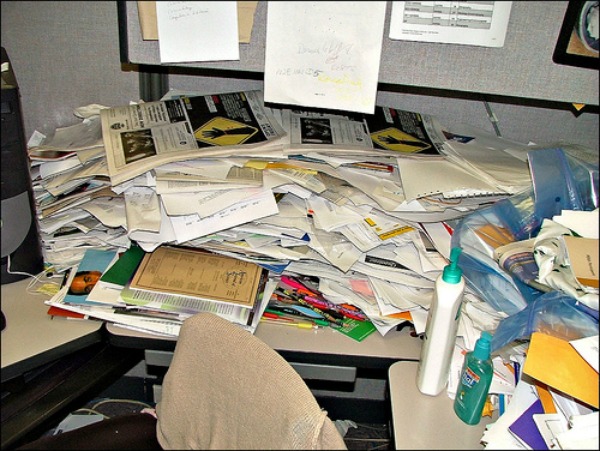What Your Messy Desk Says About You (It’s a Good Thing)
When I got back from vacation the other day, I returned to a clean desk. Well, not actually clean, but every stack of paper was aligned. Not a sheet was askew.
This lasted about 20 minutes.
But rather than stare forlornly at the paper swirl building before me, this time I gave myself a big “attaboy,” because clearly I was getting my creative on.
When things get messy
That’s right, a messy desk is a sign of an innovative mind at work, not a chaotic one. At least that’s the sage suggestion from a team of researchers at the University of Minnesota.
Here’s how they reached this conclusion. First, they arranged a room to look either particularly tidy or especially messy and haphazard. Then they invited people in for what they were told was a “consumer choice study.” The study participants were shown a menu for fruit smoothies. Actually, there were two versions of the menu. On one, smoothies with a “health boost” of added ingredients, were labeled “classic.” On the the other menu, those same smoothies were promoted as “new.”
And here’s how it played out: When people were in the tidy room, they picked smoothies with a health boost twice as often if it was labeled classic. Conversely, when they made their smoothie choices while in a messy room, they opted for those described as “new”—again twice as often. In short, they preferred convention while in a clean environment and novelty when immersed in messiness.
Interesting, but it doesn’t feel like this is quite enough to declare that messiness fosters creativity. So the Minnesota researchers, led by Kathleen Vohs, ratcheted up the research. They used the same tidy and messy rooms, only this time, they asked subjects to propose as many different uses for ping pong balls as possible. Then they had a team of independent judges rate the ideas based on the level of creativity.
Suggesting that the balls be used for beer pong wouldn’t have impressed the judges. Recommending that they could be converted into ice cube trays would.
Once again, the messy room worked its magic. As Vohs explained recently in the New York Times, the people who spent their time there offered up five times as many ideas deemed “highly creative.”
Maybe it’s time to aim a fan at the papers on my desk and start thinking deep thoughts.
It’s all about connections
If only it were that simple. Turns out that even the way our brains produce creative thoughts appears to be a lot more complicated than long believed. The conventional wisdom that the right half of our brain handles creative thinking? Way too simple—at least according to a study published last week in the journal Proceedings of the National Academy of Sciences. A team of Dartmouth scientists found that human imagination is much more of a whole brain experience.
That’s what they observed after they hooked 15 participants up to an fMRI scanner and asked them to visualize specific abstract shapes, then told them to imagine combining those shapes into more complex figures. Large networks within the subjects’ brains became active as they conjured up the images. This included areas that deal with visual processing, along with others related to attention and executive processes. All of them worked together to make the imaginary images take shape.
While their findings didn’t provide a clear answer as to why some people are more creative than others, it did allow the scientists to speculate that it may come down to a matter of connections, that in truly creative people, the different brain regions needed to shape imagination are particularly well-connected.
Creative thinking
Here’s other recent research on what may help make us creative:
- Still, they should not be encouraged to take apart the air conditioner: Researchers at Vanderbilt University say that a teenager’s ability to figure out how things work may be a better predictor of innovative thinking than more conventional math or verbal skills. The study found that students who did well on the Differential Aptitude Test, which measures the ability to manipulate two-and three-dimensional objects, often proved to be high achievers in math, science and engineering.
- I did it my way…and so should you: A study published by Northwestern University scientists challenges the notion that creative people can be a bit flighty. Instead, their research suggests just the opposite, that people who achieve creative success tend to cling to ideas, sometimes to the point where it keeps them from shifting focus.
- And you scoffed: A British psychologist commissioned by the music streaming service Spotify to determine what type of music benefits which topics of study came to the conclusion that listening to the music of Miley Cyrus can actually boost a person’s creativity.
Video bonus: Singer Annie Lennox offers her take on catching creative ideas and why it’s important to keep our internal critic out of the room at those moments.
Video bonus bonus: You gotta admit that there’s something creative about putting birds on hang gliders.
Also on Smithsonian.com
Working In a Creative Field? Despite What You Think, Coffee Is
Not Your Best Friend
10 Things We’ve Learned About Learning
Sign up for our free email newsletter and receive the best stories from Smithsonian.com each week.
http://blogs.smithsonianmag.com/ideas/2013/09/what-your-messy-desk-says-about-you-its-a-good-thing/
